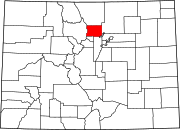Caribou, Colorado

Caribou is a former silver-mining town, now a ghost town near Nederland in Boulder County, Colorado, United States. It was named after the Caribou silver mine nearby. The Caribou Ranch recording studio is several miles away, on the road from Nederland up to Caribou.
History
1861 to 1969

A prospector named Conger discovered placer gold downstream from Caribou in 1861. He eventually followed the gold up Coon Trail Creek, and discovered the first silver vein in what later became the Caribou district.[1]
Caribou was established about 1870 to house miners from the Caribou silver mine.[2]: 51 The town had one church, three saloons, a brewery, and its own newspaper, the Caribou Post. The Caribou mine was sold for $3 million in 1871 to Dutch investors, but the new owners found that the best ore had already been removed. The mine struggled until 1876, when controversial Colorado entrepreneurs Jerome B. Chaffee and David Moffat bought the mine, incorporated it, and sold shares in New York.[3] A fire burned down the town in 1879. By the 1920s, Caribou was home to fewer than 50 people. At its peak in 1875, Caribou's population was estimated to be about 3,000 people.[4]
| Census | Pop. | Note | %± |
|---|---|---|---|
| 1880 | 549 | — | |
| 1890 | 169 | −69.2% | |
| 1900 | 44 | −74.0% | |
| 1910 | 51 | 15.9% |
1970 to present
Caribou and its silver mines were completely deserted by the time 19-year-old geology student Tom Hendricks saw it in 1970, but Hendricks became convinced that the silver mines at Caribou could make a profit, and has made the mines his life work.[5] After he got his geology degree, he acquired the old Cross mine in 1973, and began shipping silver concentrate in 1977. He acquired the famous Caribou mine in 1980. He has struggled to keep the Cross and Caribou mines operating through low silver prices.[6] Hendricks, through Calais Resources, started exploring for gold instead of silver, but business conflicts resulting in lawsuits, specifically with former Colorado senator Tom Wiens have delayed attempts at gold mining.[7]
Geography
The old townsite is at 39°58′50″N 105°34′40″W / 39.98056°N 105.57778°W, at an elevation of 10,000 feet (3,048 m) above sea level.
William Henry Jackson took a picture of the town in 1877, and well-known Colorado photographer John Fielder took another photograph of the same view in 1998. Only two stone ruins, and one collapsed wooden cabin remain of the town.[citation needed]
References
- ^ Ben H. Parker Jr., "Gold Placers of Colorado, v. 1", Quarterly of the Colorado School of Mines; v. 69, n. 3, p. 60.
- ^ Voynick, S.M., 1992, Colorado Gold, Missoula: Mountain Press Publishing Company, ISBN 0878424555
- ^ Duane A. Smith (1974) Silver Saga, Boulder, Colo.: Pruett, pp. 25-81.
- ^ John W. Buchanan (1958) The Story of Ghost Town Caribou, Boulder, Colo.: The Boulder Publishing Inc, p. 22.
- ^ Karen Auge, "Caribou's Hendricks has a heart of gold", Denver Post; 14 March 1999 p. B1.
- ^ "Hard work makes things go at a small Colorado mine", Engineering & Mining Journal, February 1982, pp. 74-76.
- ^ Steve Raabe "Colorado gold mines in play after dispute between prospector, investor", Denver Post; April 27, 2016 (updated from January 31, 2014)

